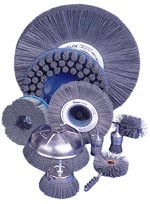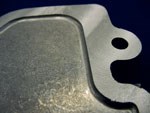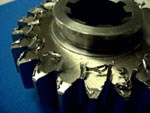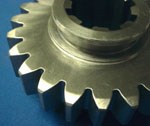Brushing Up on Deburring
The characteristics of nylon abrasive filament brushes make them an attractive option when it comes to deburring operations. But when it comes to implementing them, what is the best method? Weiler Corporation’s John Sockman looks at the possibilities…
Deburring is the Rodney Dangerfield of metal working processes. It gets no respect and even less attention. How many people have been in the following situation? After millions of dollars have been spent to develop a new manufacturing process, the customer casually mentions “don’t forget that the part has to be burr-free.” This statement usually elicits little reaction until engineering evaluates the feasibility of removing the burrs; at which point, panic attacks begin to ripple through the organization.
After the dust settles, engineering is forced to quickly review the numerous deburring processes that exist. Choosing the right one is an exercise in evaluating trade-offs. Deburring with nylon abrasive filament (NAF) brushes is one option. NAF brushes have several operational benefits that make them ideal for solving problems like radiusing edges, deburring face-milled surfaces and deburring parts that have specific surface finish requirements. The following features make NAF brushes ideal for these applications.
Self-Limiting Aggression. Compared to other abrasive products, NAF brushes are unique due to their filamentary composition. With NAF brushes, abrasive grains are presented to the work via a flexible carrier, rather than being held rigidly in place (like bonded and coated abrasives). This significantly reduces the aggression of NAF brushes relative to other abrasive products with the same grit size. When a filament contacts a burred corner, the cutting forces are high because the contact area is small. However, as soon as the filing action of the brush removes the burr and begins to erode the corner, the cutting pressure drops due to the increased contact area. The net result is that the aggression of the brush diminishes as soon as the deburring function is performed. Since NAF brushes are only aggressive on edges, they are ideal for deburring flat parts such as engine blocks and cylinder heads. These parts are machined to high tolerances, and NAF brushes are able to remove burrs without altering dimensions.
Improved Surface Finish. When a rotating filament moves across a corner of a part and transitions on to a flat surface, the cutting dynamics change completely. When a filament contacts a flat surface, the cutting pressures are very low for the reason described above. The effect of the brush is to remove the tops of asperity peaks without changing core roughness. Hence, brushes can refine surface finishes produced by most machining and grinding operations. When combined with their compliant nature, this allows them to be used to finish complicated part shapes such as automotive camshafts.
Edge Radiusing. In some applications, specifications only require the removal of a burr. However, a growing number of users in industries ranging from automotive to aerospace require more than burr removal. They require an edge radius in a particular size range. And, they expect the deburring system to be capable of producing this edge radius. The self-limiting aggression of NAF brushes allows them to accurately produce specific edge radii. Further, the ability of NAF brushes to blend the corner into the adjacent sides results in the creation of a true radii as opposed to the chamfer which results from some other deburring processes. Aircraft engine and airframe components are examples of parts that are commonly processed with NAF brushes in order to achieve specific edge radii.
Easy To Automate. Due to the forgiving nature of NAF brushes, they are much easier to automate than other metalworking tools. Unlike machining and grinding, a high level of precision is not needed in most brush deburring applications. This eliminates the complexities of planning for part-to-part variation arising from casting variances and fixturing tolerances. Brushes normally operate very effectively in a window of +/- 0.020 inch.
Like all processes, deburring with NAF brushes has shortcomings. The following points summarize the most commonly encountered problems in NAF brush deburring processes.
Equipment Requirements. In simplest terms, NAF brushes are a collection of flexible files. To work well, each filament must be allowed to flow across the edge of the part. This requires relatively low surface speeds (2,500 sfpm or less) and sufficient motor torque to prevent bogging when the part penetrates the brush face. As a result, NAF brushes do not work well on standard bench and pedestal grinders, which run at 3,450 rpm, producing surface speeds of 5,400 sfpm or more.
Small Bores. Internal bores smaller than 3/4 inch in diameter are difficult to deburr with brushes. Tube brushes can remove loose and hanging burrs from intersecting holes, but their filament density is insufficient to remove most well-attached burrs. Based on consumable-cost-per-part, tube brush deburring systems are often expensive to operate. A rule of thumb is to implement tube brush deburring when all other reasonable alternatives have been exhausted.
Masking. Part geometry is more important in designing brush deburring processes than in many alternative deburring processes such as mass finishing. To be effective, brush filaments need unimpeded perpendicular access to the burred edge. If protruding part features deflect the filaments away from a targeted edge, the brush deburring process is unlikely to work well. Similarly, if clamps and/or fixtures prevent perpendicular filament flow, the process will be unreliable.
Incoming Burr Condition. All deburring processes are affected by part-to-part variation in burr condition. The more stable the burr condition, the more reliable the deburring process. NAF brushes are compliant tools and are capable of processing parts with a variety of burr sizes. However, all new processes should be designed around the worst case burr condition to ensure process integrity.
If a part seems to be a good candidate for NAF brush deburring, the next decision concerns the means of implementation – how is the brush going to be presented to the part or vice versa? The following are common methods for implementing deburring with NAF brushes along with pros and cons.
In-Machine Deburring
Deburring using the same equipment that produces the burr is the most elegant of all deburring technologies. It requires no incremental floor space, no capital expenditure on new equipment and does not require a secondary process that can create WIP, increasing non-value-added labor content. Further, in-machine deburring creates single-point accountability for part dimensioning. This ends the bickering and finger-pointing that often occurs when machining and deburring are handled by different groups in a manufacturing facility.
The most significant disadvantage of in-machine deburring is that it cannot be implemented when machining is the overall process bottleneck and cycle time increases equate to lost production. However, many plants have excess machining capacity and using it for deburring is more viable than purchasing custom deburring equipment.
Robotic Deburring
The key benefit of robotic deburring systems is flexibility: flexibility in capital utilization and flexibility in media delivery. In terms of capital utilization, robots are excellent tools because they can be used for jobs ranging from deburring to part handling. When a project has been completed and a robot’s life as a deburring tool is finished, it can frequently be employed for another task. In terms of media delivery, robotic systems are ideal. Since they can easily produce any part-brush orientation, they are uniquely capable of processing complicated part-geometries such as turbine blades, which require filaments to attack many edges from many angles.
Another important note about robots is that they can be easily implemented into existing production lines. A robot is the perfect tool for picking a part from a conveyor, deburring it and returning it to the conveyor. This type of movement can often be done within the cycle time of a production line, not affecting throughout. In some cases, material handling robots can be used to deburr targeted edges while they are moving a part from Point A to Point B.
The primary disadvantage of robotic deburr-ing systems, compared to other brush deburring systems, is their high system-cost-to-cycle-time ratio. Robotic systems can easily exceed $250,000 and the cycle times produced by such systems are not particularly high. However, robots are the only way to deburr some parts and their flexibility is a significant factor.
Dedicated Equipment
Equipment that is dedicated to deburring a specific part, or family of parts, is a viable option in two environments. First, small, dedicated machines can fit into cells and be used to deburr parts on a single-part-flow basis. Their rates can be matched to the output of the cell, allowing them to be run by the cell operator, thereby eliminating incremental direct labor.
The second environment in which dedicated machines are very practical is high-production facilities where cycle time minimization is imperative. Because custom equipment is optimized for a specific part, high-throughput dedicated machines can deburr high volumes of parts (600/hr or more) and handle the output of several up-stream metalworking processes.
Lastly, dedicated machines are ideal for projects that are under contract for several years. This allows full amortization of the equipment. This contrasts to robotic cells in which the robot can be redeployed to another job when its deburring duties are complete.
The proceeding information provides insights into the types of applications and implementation vehicles that are appropriate for deburring with NAF brushes. Significant application details were glossed over or neglected completely due to space. Users considering NAF brush deburring should contact one of the brush manufacturers to discuss the details of their application. Most companies supply no-charge consulting as well as in-house labs for processing sample parts and evaluating alternative solutions.
Read Next
Episode 45: An Interview with Chandler Mancuso, MacDermid Envio Solutions
Chandler Mancuso, technical director with MacDermid Envio discusses updating your wastewater treatment system and implementing materials recycling solutions to increase efficiencies, control costs and reduce environmental impact.
Read MoreDelivering Increased Benefits to Greenhouse Films
Baystar's Borstar technology is helping customers deliver better, more reliable production methods to greenhouse agriculture.
Read MoreA ‘Clean’ Agenda Offers Unique Presentations in Chicago
The 2024 Parts Cleaning Conference, co-located with the International Manufacturing Technology Show, includes presentations by several speakers who are new to the conference and topics that have not been covered in past editions of this event.
Read More

















.jpg;maxWidth=300;quality=90)






